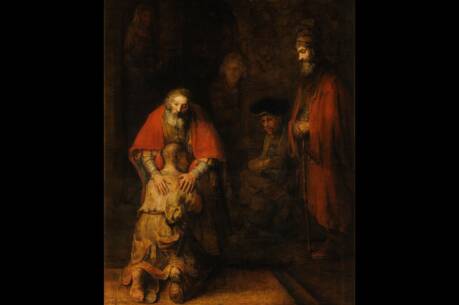Hope Amid the Ruins
Karl Barth, one of the great theologians of the past century, urged people to read the Bible with a copy of the daily newspaper at their side. He realized that the Bible could challenge the way we view human life. I write these lines three days after the horrendous catastrophe that has washed over so many human lives when airliners were turned into flying coffins to be used as weapons of mass destruction. Like many, I move between shocked disbelief as the same pictures roll by hour after hour, through deep sadness and sympathy, while trying to stifle thoughts of anger and revenge.
This Sunday’s Gospel delivers a message that many of us find difficult to absorb. On first reading, it is a story of Jesus healing 10 people from a physically devastating and socially isolating disease, along with the example of a single one who “returned to give thanks to God,” in contrast to the other nine. Yet the shock of the story, which drastically enriches its power, is in the simple phrase that the one who returned “was a Samaritan.”
At the time of Jesus, bitter hatred had long existed between Jew and Samaritan, even though they shared the Torah and venerated Moses. Like most deep-seated hatreds, the origin of the differences had long been buried under almost four centuries of violence and resentment. While recognizing the Pentateuch and revering Moses, the Samaritans rejected the royal Davidic ideology and resisted the rebuilding of the temple after the Babylonian exile. Their place of worship was not Jerusalem but Mount Gerizim, where their temple had been burned by the Jewish high priest John Hyrcanus in 128 B.C. Shortly before Jesus’ ministry at Passover, some Samaritans entered the Jewish temple secretly and scattered human bones in the temple, forcing the cancellation of temple service and precipitating strict security around the temple (reported by Josephus in Jewish Antiquities). Later, Samaritans killed some Galileans who were making a festive pilgrimage to Jerusalem. In reprisal, the Galileans enlisted a certain Eleazer, a notorious bandit chieftain, to burn Samaritan villages. The Gospel of John reflects this hatred in the surprise of the Samaritan woman that Jesus would ask her for a drink of water (Jn. 4:9) and the charge by Jesus’ opponents that he is “a Samaritan and [demonically] possessed” (Jn. 8:48).
The great shock of the narrative is, then, that the one who returns “glorifying God in a loud voice” and who gave thanks to God is a Samaritan, whom Jesus calls “a foreigner.” (The Greek literally means “a person of a different kind or nature.”) This positive view of the Samaritan should be joined with the other major Samaritan incident, the parable of the “Good Samaritan.” These two Samaritan stories provide an arch from the initial stages of Jesus’ long journey to Jerusalem to near its conclusion. Taken together the two narratives provide exemplars of the greatest of commandments—to love and praise God with one’s whole heart and soul and to love one’s neighbor as oneself. Here the hated foreigner and outsider becomes a model for Jesus’ Jewish hearers of the deepest meaning of God’s revelation. The story also breaks through deep-seated images of the enemy and fosters respect and forgiveness.
Among the tragic victims of the destruction of United flight 93 was Deora Bodley, a junior at Santa Clara University in California. When Paul Locatelli, S.J., the university’s president, talked with the parents, they replied that Deora and they “would want peace among people and an earth that reflects harmony among all people, not recrimination or revenge.” Such sentiments echo those of another person who died by violence in the prime of life: “Love your enemies, do good to those who hate you, bless those who curse you” (Lk. 6:27-28).
The Gospel cautions us today, even in the face of the recent horror, against characterizing people of another race or religion as enemies. This is no message of the “cheap grace” of easy forgiveness. In the story itself, both Jew and Samaritan are healed of an illness that isolates them from the human family. Only after being healed does the Samaritan leper return to give thanks and praise. The reconciling ministry of the church today does not require blindness to the evil that infects humanity, but commitment to a long-term mission to free ourselves and those who would harm us from deep-seated hatreds and prejudice. The day after the heartbreaking events of Sept. 11, there opened in Sarajevo an international conference entitled “Christians and Muslims in Europe: Responsibility and Religious Commitment in a Pluralised Society,” with representatives of the leadership bodies of Catholics, Protestants and Muslims. As Sept. 11, 2001, sears our memories, we can only hope and pray constantly that Sept. 12 will provide healing balm.
This article also appeared in print, under the headline “Hope Amid the Ruins,” in the October 8, 2001, issue.







